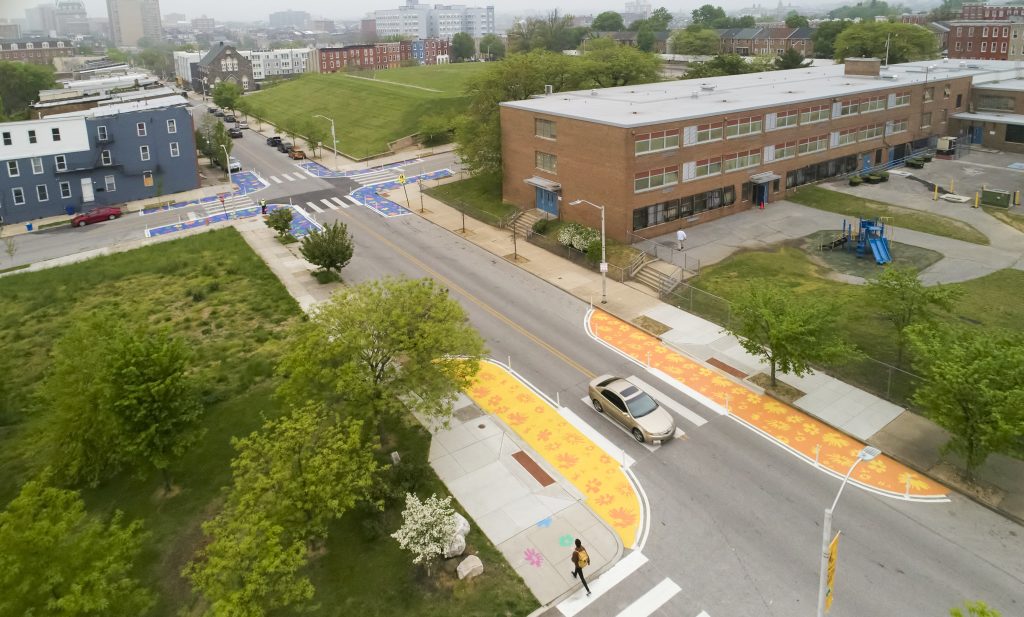
By David Andersson, Bloomberg Philanthropies’ Arts Team
In East Baltimore’s Johnston Square, community members are seeking safer streets. The residential neighborhood sits just outside Baltimore’s central business district, and the local elementary school is sandwiched between two wide streets that drivers speed down as a cut-through to other parts of the city.
Dolores McKoi, a crossing guard posted near the school, sees the danger every day. “I’ve had the problem of children almost getting hit by cars not stopping,” she said in a video interview. The city’s transportation department clocked vehicle speeds as high as 85 MPH during school hours.
The community and the city came together to identify an innovative way to tackle this challenge: asphalt art.
“Bee Safe Art Crosswalks,” a project of our Asphalt Art Initiative, transformed three intersections around the school with artistic safety redesigns. Prior to the artwork being installed, only 37% of drivers yielded to pedestrians with the right of way; after the project was completed in April 2022, 78% now yield to pedestrians.
Use the slider to see before and after images of one of the three artistic intersections designed as part of the “Bee Safe Art Crosswalks” project in Baltimore.
The Asphalt Art Initiative supports cities using art and community engagement to improve street safety and revitalize public space. Through colorful crosswalks, intersection murals, and artistic pedestrian plazas, asphalt art is a relatively inexpensive way to create temporary improvements to city streets that make them safer and more welcoming for the residents and visitors who use them every day.
To date, the Initiative has supported 45 projects in the United States and Europe, including a new 18,000-square-foot event plaza in Reno, Nevada; a transformed highway underpass in Glasgow, Scotland; and a series of community-designed utility boxes in Sioux Falls, South Dakota. In Kansas City, Missouri, the artistic redesign of an intersection rife with speeding cars saw average traffic speeds drop by 45%.
Bloomberg Philanthropies’ recent Asphalt Art Safety Study, conducted by Sam Schwartz Consulting, showed that promising stats like the ones in Baltimore and Kansas City were not anomalies. Across the 22 asphalt art projects studied, the rate of traffic crashes involving pedestrians or cyclists dropped by 50%, and the rate of drivers yielding to pedestrians with the right of way grew by 27%.
In Baltimore, the “Bee Safe” project was a true collaborative effort between community members, artists, and city government.
Through a series of community design workshops organized by neighborhood association ReBuild Johnston Square, an artist team from the Maryland Institute College of Art worked with community members to create the design for the project, including a flower and bee pattern representing the neighborhood and alternating color combinations to give each intersection a unique feel.
Baltimore’s Department of Transportation created the “canvas” for the designs by installing curb bump-outs (also known as curb extensions) that increase safe space for pedestrians at each intersection, shortening the crossing distances and narrowing the traffic lanes to encourage drivers to slow down. The murals were installed over two weekends in spring 2022 with the help of 100 community volunteers.

The “Bee Safe” asphalt art project has been a resounding success with Johnston Square residents. And the elementary school has been able to adopt a more family-friendly dismissal policy, going from a single location at the school’s front entrance to smaller group dismissals at multiple entrances now that the walk home is safer.
In a recent community survey, one neighborhood resident wrote, “I use less time to cross because of the artwork. The bump-outs also make it easier for cars to see me while I am waiting to cross. I feel they notice me more and slow down for me.” The art signals to drivers that the streets are not only for cars, but for people too.

There is more to come for the Asphalt Art Initiative. More than a dozen projects will be installed this year across the United States, including a series of colorful crosswalks in Starkville, Mississippi; a new “welcome plaza” for tourists visiting Kodiak, Alaska; and a walking lane in Atlanta, Georgia. The Initiative is also expanding in Europe and will announce grants to European cities this fall.
The Asphalt Art Initiative was designed to inspire and encourage city and community leaders to explore how creative street interventions might help them tackle road challenges in their cities. In Baltimore, the design team is encouraging other community members to follow in their footsteps, creating an “Art in the Right of Way” handbook for installing asphalt art, as well a toolbox with necessary equipment (such as paint trays, safety vests, even a pressure washer) that can be borrowed for free from a local library branch.
As Steve Sharkey, Director of Baltimore’s Department of Transportation, said: “Asphalt art is a great way to test out street safety because it brings the community to it. You get a safer neighborhood for people to walk, and you get artwork that people can enjoy and have pride in their neighborhood.”
To read more about our projects and to download our free Asphalt Art Guide, visit: asphaltart.bloomberg.org

